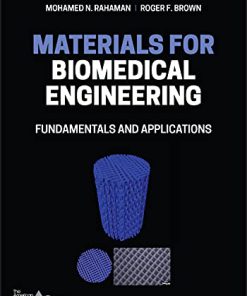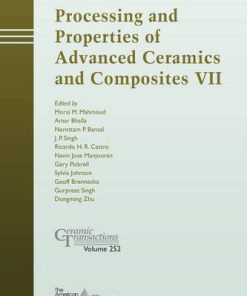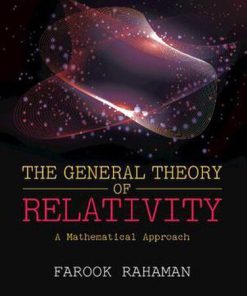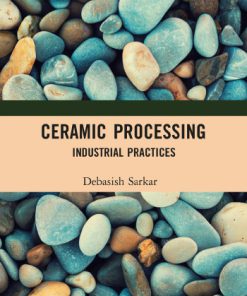Ceramic processing 2nd edition by Rahaman 9781498716413 1498716415
$50.00 Original price was: $50.00.$25.00Current price is: $25.00.
Ceramic processing 2nd edition by Rahaman- Ebook PDF Instant Download/Delivery:9781498716413,1498716415
Full download Ceramic processing 2nd edition after payment
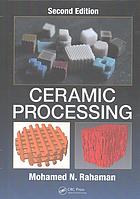
Product details:
ISBN 10:1498716415
ISBN 13:9781498716413
Author:Rahaman
Many of the properties critical to the engineering applications of ceramics are strongly dependent on their microstructure which, in turn, is dependent on the processing methods used to produce the ceramic material. Ceramic Processing, Second Edition provides a comprehensive treatment of the principles and practical methods used in producing ceramics with controlled microstructure.
Covering the main steps in the production of ceramics from powders, the book also provides succinct coverage of other methods for fabricating ceramics, such as sol−gel processing, reaction bonding, chemical vapor deposition and polymer pyrolysis.
While maintaining the objectives of the successful first edition, this new edition has been revised and updated to include recent developments and expanded to feature new chapters on additives used in ceramic processing; rheological properties of suspensions, slurries, and pastes; granulation, mixing, and packing of particles; and sintering theory and principles.
Intended as a textbok for undergraduate and graduate courses in ceramic processing, the book also provides an indispensable resource for research and development engineers in industry who are involved in the production of ceramics or who would like to develop a background in the processing of ceramics.
Ceramic processing 2nd Table of contents:
Chapter 1 Ceramic Fabrication Processes – An Introductory Overview
1.Introduction
2. Ceramic Fabrication Processes
3.Fabrication of Ceramics from Powders: An Overview
1.3.1 Powder Synthesis and Characterization
1.3.2 Powder Consolidation
1.3.3 The Sintering Process
1.3.4 Ceramic Microstructures
1. Case Study in Processing: Fabrication of Al2O3 from Powders
2. Concluding Remarks
Referenes
Chapter 2 Synthesis and Preparation of Powders: Mechanical Methods
2.1 Introdtion
2.2 Powder Characteristics
2.3 Powder Preparation by Mechanical Methods
2.4 High Compression Roller Mills
2.5 Jet Mills
2.6 Ball Mills
2.7 High-Energy Ball Milling
2.8 Concluding Remarks
Problems
References
Chapter 3 Powder Synthesis by Chemical Methods
3.1 Introduction
3.2 Solid State Reactions
3.2.1 Decomposition
3.2.2 Reaction between Solids
3.3.2 Reduction
3.3 Precipitation from Liquid Solutions
3.3.1 Principles of Precipitation from Solution
3.3.2 Methods for Preparing Powders by Precipitation from Solution
3.3.3 Precipitation Methods Based on Evaporation of the Liquid
3.4 Freeze Drying
3.5 Gel Routes
3.5.1 Sol- Gel Processing
3.5.2 Pechini Method
3.5.3 Citrate Gel Method
3.5.4 Glycine Nitrate Process
3.6 Non-Aqueous Liquid Reactions
3.7 Vapor Phase Reactions
3.7.1 Gas- Solid Reaction
3.7.2 Reaction between Gases
3.8 Concluding Remarks
Problems
References
Chapter 4 Synthesis of Ceramic Nanoparticles
4.1 Introduction
4.2 Methods for Synthesizing Ceramic Nanoparticles
4.3 Solid- Solid Methods
4.4 Solid- Vapor- Solid Methods
4.5 Liquid- Solid Methods
4.6 Liquid- Vapor- Solid Methods
4.7 Concluding Remarks
Problems
References
Chapter 5 Powder Characterization
5.1 Introduction
5.2 Physical Characterization
5.2.1 Types of Particles
5.2.2 Particle Size and Particle Size Distribution
5.2.3 Particle Shape
5.2.4 Measurement of Particle Size and Size Distribution
5.2.5 Surface Area
5.2.6 Porosity of Particles
5.3 Chemical Composition
5.4 Crystal Structure and Phase Composition
5.5 Surface Characterization
5.5.1 Surface Structure
5.5.2 Surface Chemistry
5.6 Concluding Remarks
Problems
References
Chapter 6 Science of Colloidal Processing
6.1 Introduction
6.2 Types of Colloids
6.3 Attractive Surface Forces
6.3.1 Van der Waals Forces between Atoms and Molecules
6.3.2 Van der Waals Forces Macroscopic Bodies
6.3.3 The Hamaker Constant
6.3.4 Effect of the Intervening Medium
6.4 Stabilization of Colloidal Suspensions
6.5 Electrostatic Stabilization
6.5.1 Charges on Particles in a Liquid
6.5.2 Origins of the Electrical Double Layer
6.5.3 Isolated Double Layer
6.5.4 Surface Charge
6.5.5 Repulsion between Two Double Layers
6.5.6 Stability of Electrostatically Stabilized Colloids
6.5.7 Kinetics of Flocculation
6.5.8 Electrokinetic Phenomena
6.6 Steric Stabilization
6.6.1 Adsorption of Polymers from Solution
6.6.2 Origins of Steric Stabilization
6.6.3 Effect of Solvent and Temperature
6.6.4 Stability of Sterically Stabilized Suspensions
6.6.5 Stabilization by Polymers in Free Solution
6.7 Electrosteric Stabilization
6.7.1 Dissociation of Polyelectrolytes in Solution
6.7.2 Adsorption of Polyelectrolytes from Solution
6.7.3 Stability of Electrosterically Stabilized Suspensions
6.8 Structure of Consolidated Colloids
6.9 Concluding Remarks
Problems
References
Chapter 7 Rheology of Colloidal Suspensions, Slurries and Pastes
7.1 Introduction
7.2 Types of Rheological Behavior
7.2.1 Viscous Flow Behavior
7.2.2 Viscoelastic Behavior
7.3 Rheological Measurement
7.4 Factors Influencing the Viscosity of Colloidal Suspensions
7.4.1 Interparticle Forces
7.4.2 Particle Concentration
7.4.3 Particle Size and Particle Size Distribution
7.4.4 Particle Morphology
7.4.5 Suspension Medium
7.5 Concluding Remarks
Problems
References
Chapter 8 Processing Additives
8.1 Introduction
8.2 Types of Additives
8.3 Solvents
Selection of a Solvent
8.4 Dispersants
8.4.1 Inorganic Acid Salts
8.4.2 Surfactants
8.4.3 Low to Medium Molecular Weights Polymers
8.5 Binders
8.5.1 Inorganic Binders
8.5.2 Synthetic Organic Binders
8.5.3 Natural Organic Binders
8.5.4 Selection of a Binder
8.6 Plasticizers
8.7 Other Potential Additives
8.8 Concluding Remarks
Problems
References
Chapter 9 Granulation, Mixing and Packing of Particles
9.1 Introduction
9.2 Granulation of Particles
9.2.1 Desirable Characteristics of Binders
9.2.2 Preparation of Granules
9.2.3 Spray Drying
9.2.4 Factors Controlling the Strength of Granules
9.2.5 Spray Freeze Drying
9.3 Mixing of Particles
9.3.1 Mixing and Segregation Mechanisms
9.3.2 Mixture Composition and Quality
9.3.3 Statistical Methods
9.3.4 Measurement Techniques
9.3.5 Mixing Technology
9.4 Packing of Particles
9.4.1 Regular Packing of Monosize Spheres
9.4.2 Random Packing of Particles
9.4.3 Packing of Continuous Size Distributions
9.5 Concluding Remarks
Problems
References
Chapter 10 orming of Ceramics; Conventional Methods
10.1 Introduction
10.2 Dry and Semi-Dry Pressing
10.2.1 Die Pressing
10.2.2 Isostatic Pressing
10.3 Suspension-Based Methods
10.3.1 Slip Casting
10.3.2 Pressure Casting
10.3.3 Tape Casting
10.3.4 Centrifugal Consolidation
10.3.5 Dip and Spin Coating
10.3.6 Electrophoretic Deposition
10.3.7 Freeze Casting
10.3.8 Gelcasting
10.3.9 Direct Coagulation Casting
10.3.10 Aqueous Injection Molding
10.4 Plastic Forming Methods
10.4.1 Extrusion
10.4.2 Injection Molding
10.5 Concluding Remarks
Problems
References
Chapter 11 Additive Manufacturing of Ceramics
11.1 Introduction
11.2 Powder-Based Methods
11.2.1 Selective Laser Sintering
11.2.2 Three-Dimensional Printing
11.3 Particle-Filled Polymer Methods
11.3.1 Fused Deposition Modeling
11.3.2 Laminated Object Manufacturing
11.4 Suspension-Based Methods
11.4.1 Stereolithography
11.4.2 Inkjet Printing
11.4.3 Robocasting
11.4.4 Freeze Extrusion Fabrication
Problems
References
Chapter 12 Drying, Debinding and Microstructural Characterization of Green Articles
12.1 Introduction
12.2 Drying of Granular Ceramics
12.2.1 Drying of Drops of a Suspension on a Surface
12.2.2 Drying of Adherent Coatings
12.2.3 Drying of Three-Dimensional Solids
12.2.4 Drying Technology
12.3 Binder Removal
12.3.1 Extraction by Capillary Flow
12.3.2 Solvent Extraction
12.3.3 Supercritical Extraction
12.3.4 Thermal Debinding
12.3.5 Thermal Debinding Process Design
12.4 Green Microstructures and Their Characterization
12.5 Concluding Remarks
Problems
References
Chapter 13 Sintering Theory and Fundamentals
13.1 Introduction
13.1.1 Types of Sintering
13.1.2 Measurement of Sintering
13.1.3 Analysis of Sintering
13.2 Solid-State Sintering
13.2.1 Driving Force for Sintering
13.2.2 Effects of Surface Curvature
13.2.3 Grain Boundary Effects
13.2.4 Mechanisms of Sintering
13.2.5 Stages of Sintering
13.2.6 Theoretical Analysis of Solid-State Sintering
13.3 Grain Growth in Solid-State Sintering
13.3.1 Types of Grain Growth
13.3.2 Importance of Controlling Grain Growth
13.3.3 Normal Grain Growth
13.3.4 Abnormal Grain Growth
13.3.5 Ostwald Ripening
13.3.6 Control of Grain Growth
13.3.7 Grain Growth in Porous Ceramics
13.3.8 Simultaneous Densification and Grain Growth
13.4 Viscous Sintering
13.5 Liquid-Phase Sintering
13.5.1 Stages of Liquid-Phase Sintering
13.5.2 Microstructures of Liquid-Phase Sintered Ceramics
13.5.3 Role of Solid-State Sintering in Liquid-Phase Sintering
13.5.4 Thermodynamic and Kinetic Factors
13.5.5 Mechanisms of Liquid-Phase Sintering
13.5.6 Phase Diagrams in Liquid-Phase Sintering
13.6 Pressure-Assisted Sintering
13.6.1 Pressure-Assisted Sintering Models
13.6.2 Mechanisms of Pressure-Assisted Sintering
13.7 Field-Assisted Sintering Techniques
13.7.1 Spark Plasma Sintering
13.7.2 Flash Sintering
13.8 Concluding Remarks
Problems
References
Chapter 14 Sintering Process Variables and Techniques
14.1 Introduction
14.2 Sintering Furnaces and Furnace Supports
14.3 Effect of Particle Size and Packing
14.3.1 Particle Size
14.3.2 Particle Size Distribution
14.3.3 Particle Shape and Particle Structure
14.3.4 Particle Packing
14.3.5 Effect of Green Density
14.4 Anisotropic Shrinkage
14.4.1 Pore Shape Anisotropy
14.4.2 Particle Alignment
14.5 Heating Schedule
14.5.1 Design and Prediction of the Heating Schedule
14.5.2 Effect of Heating Rate on Sintering
14.5.3 Special Heating Schedules
14.6 Sintering Atmosphere
14.6.1 Gases in Pores
14.6.2 Effect on Vapor Transport
14.6.3 Volatilization and Decomposition
14.6.4 Oxidation State
14.7 Microwave Sintering
14.8 Pressure-Assisted Sintering
14.8.1 Hot Pressing
14.8.2 Hot Isostatic Pressing
14.9 Spark Plasma Sintering
14.10 Sintering of Ceramic Composites, Coatings and Multilayers
14.10.1 Sintering of Ceramic Composites
14.10.2 Sintering of Adherent Coatings
14.10.3 Co-sintering of Ceramic Multilayers
14.11 Conclusions
Problems
References
14.9 Spark Plasma Sintering
14.10 Sintering of Ceramic Composites, Coatings and Multilayers
14.10.1 Sintering of Ceramic Composites
14.10.2 Sintering of Adherent Coatings
14.10.3 Co-sintering of Ceramic Multilayers
Chapter 15 Sol−Gel Processing
15.1 Introduction
15.2 Sol−Gel Processing of Aqueous Silicates
15.3 Metal Alkoxides
15.3.1 Preparation of Metal Alkoxides
15.3.2 Basic Properties of Metal Alkoxides
15.4 Sol−Gel Processing of Silicon Alkoxides
15.4.1 Precursors
15.4.2 Hydrolysis and Condensation
15.4.3 Polymer Growth
15.4.4 Gelation
15.4.5 Drying of Gels
15.4.6 Gel Densification during Sintering
15.5 Sol−Gel Preparation Techniques
15.5.1 Preparation of Particulate Gels
15.5.2 Preparation of Polymeric Gels
15.6 Applications of Sol−Gel Processing
15.6.1 Thin Films and Coatings
15.6.2 Fibers
15.6.3 Monoliths
15.6.4 Porous Materials
15.6.5 Porous Materials
15.7 Concluding Remarks
Problems
References
Chapter 16 Ceramic Fabrication Methods for Specific Shapes and Architectures
16.1 Introduction
16.2 Chemical Vapor Deposition
16.2.1 Plasma-Assisted Chemical Vapor Deposition
16.2.2 Chemical Vapor Infiltration
16.3 Directed Metal oxidation
16.4 Reaction Bonding
16.4.1 Reaction-Bonded Silicon Nitride
16.4.2 Reaction-Bonded Silicon Carbide
16.4.3 Reaction Bonding of Oxide Ceramics
16.5 Polymer Pyrolysis
16.6 Fabrication Routes for Fiber-Reinforced Ceramic Matrix Composites
16.6.1 Processing of SiC Fiber-Reinforced SiC Matrix Composites
16.6.2 Processing of Oxide Fiber-Reinforced Oxide Matrix Composites
16.7 Concluding Remarks
People also search for Ceramic processing 2nd:
ceramic processing mohamed n rahaman
ceramic processing and sintering rahaman pdf
ceramic processing rahaman pdf
mn rahaman ceramic processing
how long does ceramic pro take to cure
Tags:
Rahaman,processing,Ceramic,2nd edition
You may also like…
Physics - Relativity
The General Theory of Relativity A Mathematical Approach 1st Edition Farook Rahaman
Engineering
Modern Ceramic Engineering Properties Processing and Use in Design Fourth Edition David W. Richerson




